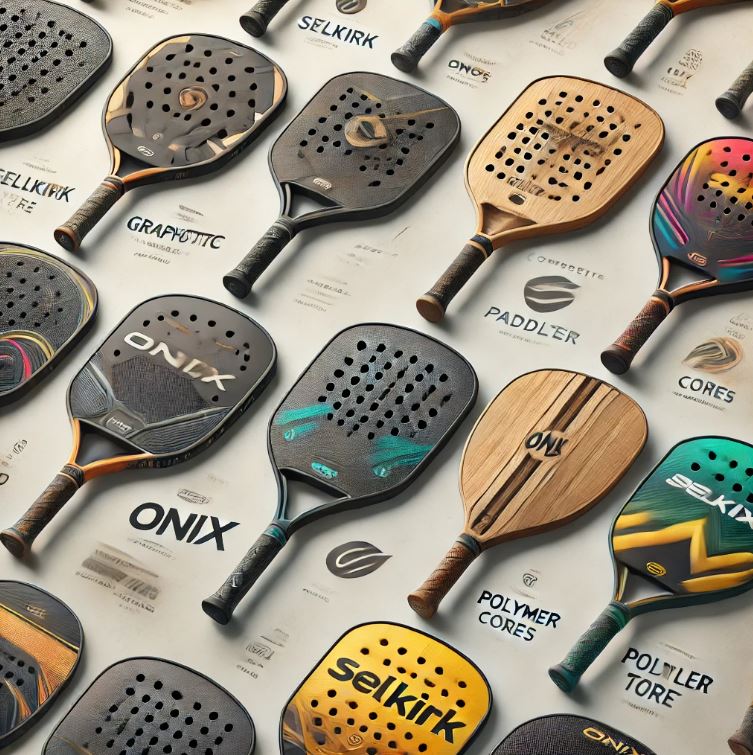I'm a participant in the Amazon Services LLC Associates Program, an affiliate advertising program designed to provide a means for me to earn fees by linking to Amazon.com and affiliated sites.
Pickleball paddles have evolved significantly since the sport’s inception, with modern paddles crafted from advanced materials to enhance performance. Understanding the construction of these paddles can help players make informed decisions when selecting equipment. This article explores the materials used in pickleball paddles, their benefits, and recent developments in the field. What are pickleball paddles made of? You’ll soon know the answer.
For the best ones, check our guide on the top pickleball paddles to see which ones rank near the top.
Key Takeaways
- Pickleball paddles are made from various materials, each offering unique advantages.
- Recent advancements in materials and design have improved paddle performance.
- Knowledge of paddle construction can help players choose the best equipment for their needs.
Materials Used in Pickleball Paddles
Graphite
Graphite is a popular material for pickleball paddles due to its lightweight nature and excellent strength. Paddles with graphite faces provide superior control and touch, making them ideal for players who prioritize precision.
Benefits:
- Lightweight for easy maneuverability
- High strength-to-weight ratio
- Enhanced control and accuracy
Example: The Onix Graphite Z5 is a well-known paddle featuring a graphite face, praised for its balance of power and control.
Composite
Composite paddles are made from a combination of materials, typically including fiberglass and carbon fiber. These paddles offer a balance of power and control, making them versatile for different playing styles.
Benefits:
- Versatility in performance
- Durable construction
- Good balance of power and control
Example: The Paddletek Tempest Wave Pro uses composite materials to provide a responsive feel and excellent playability.
Wood
Wooden paddles are the traditional choice and are often used by beginners due to their affordability. However, they are heavier and offer less advanced performance characteristics compared to modern materials.
Benefits:
- Affordable and accessible
- Durable
- Great for recreational play
Example: Basic wooden paddles are commonly used in schools and community centers for introductory pickleball sessions.
Polymer Core
The core of the paddle significantly affects its performance. Polymer cores are the most common in modern paddles, offering a soft feel and good control.
Benefits:
- Soft feel for better control
- Reduces vibrations
- Suitable for players of all skill levels
Example: The Selkirk AMPED S2 features a polymer core, enhancing its control and comfort during play.
Nomex Core
Nomex is a type of honeycomb material that provides a stiffer and more responsive feel. Paddles with Nomex cores are known for their power and durability.
Benefits:
- High durability
- Powerful and responsive
- Consistent performance
Example: The Engage Encore Pro utilizes a Nomex core, offering players a powerful hitting surface.
Recent Developments in Pickleball Paddle Materials
The pickleball industry continues to innovate, with manufacturers exploring new materials and technologies to enhance paddle performance. Recent developments include:
- Carbon Fiber Integration: Increasing use of carbon fiber in paddle faces for improved durability and control.
- Enhanced Core Technologies: New core designs, such as multi-layer polymer cores, provide better shock absorption and performance consistency.
- Ergonomic Handle Designs: Advances in handle design reduce strain and improve comfort, allowing for longer play sessions without fatigue.
Top Experts and Entities in Pickleball
USA Pickleball Association (USAPA)
The USAPA plays a pivotal role in standardizing equipment and promoting the sport across the United States. Their guidelines and certifications ensure quality and consistency in pickleball gear.
Pickleball Magazine
A leading publication dedicated to pickleball, offering insights, reviews, and expert opinions on the latest equipment and trends in the sport.
Top Players
Professional players like Ben Johns and Simone Jardim often share their preferences and experiences with different paddles, providing valuable insights for enthusiasts looking to improve their game.
Key Takeaways – What Are Pickleball Paddles Made Of?
- Pickleball paddles are crafted from materials like graphite, composite, wood, and polymer cores, each offering distinct benefits.
- Recent advancements in materials and design have led to more durable and high-performing paddles.
- Expert insights and staying updated with industry trends can help players make the best equipment choices.
Internal Links
- Best Protein Bars for Weight Loss 2024
- When Do Protein Bars Expire?
- Recipe for Protein Bars with Peanut Butter
- Unhealthiest Protein Bars 2024
- Protein Bars Before or After Workout
Author
This article is written by Trimflo, an expert in the field of pickleball equipment with many years of experience.
By understanding the materials used in pickleball paddles and staying informed about recent developments, players can choose the best equipment to enhance their game.
